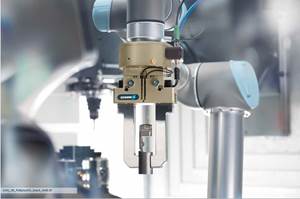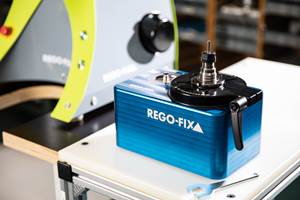Show Me the Fixtures
Innovative workholding devices intrigue me. If you’ve developed what you consider to be a nifty workholding solution of your own, I’d like to see it.
Share





I appreciate that we cover a range of machining topics in this magazine and, in doing so, get to visit a variety of shops. Regardless of the article topic, however, I’m always curious to see how shops fixture parts for machining.
It’s interesting to see unique workholding devices a clever person has created for odd parts. But it’s just as neat to see custom devices that provide a more effective way to secure parts with straightforward geometries. Mike Brown, the vice president of manufacturing at E.F. Bavis, has developed a number of interesting job-specific fixtures over the years for both scenarios. I got to see some of those when I met with him to develop the story that starts on page 88. Plus, each of his three CNC toolroom mills has a pin in the center of the table onto which the fixtures are located. This speeds changeovers by eliminating the need to indicate fixtures before starting a job.
One of the niftiest workholding solutions I’ve come across is nicknamed the “lollipop” and was developed by Harmonic Drive LLC. The company needed to secure small, bell-shaped workpieces called flexsplines for turning, spline machining and OD inspection. The part, which begins as a 15-5PH stainless steel forging, first has its ID turned. This creates a wall thickness of approximately 0.06 inch. A final wall thickness of 0.01 inch is attained through OD turning. Because of the part’s shape and extremely thin wall thickness at this stage, it can’t be clamped in a lathe’s chuck. The thin walls would not provide adequate support during the turning operation.
To solve its workholding dilemma, the company decided to machine an arbor from a Sandvik Capto boring bar blank onto which the flexspline can be mounted. However, because of the part’s bell-like internal profile, voids exist between the arbor and inner surface of the workpiece. To fill these voids, the shop pours a low-melt-temperature alloy through a bore down the center of the arbor. Once the alloy fills the voids and solidifies, the part and arbor bond together to become one piece. Therefore, the alloy provides the internal wall support required to turn the part’s OD to the desired wall thickness. After all machining and inspection operations are completed, the alloy is melted away and the completed flexspline is removed from the arbor.
Of course, many job shops approach new projects expecting to use a vise. This is understandable, because these universal devices enable them to accommodate the wide range of parts they encounter. So while a vise might not be the ideal workholding solution, shops justify them because it can be impractical, too costly or time consuming to engineer and make custom fixtures for a job they may never see again.
Conversely, other shops have found value in making the investment to create custom workholding devices. In fact, some have gone on to turn their ideas into marketable products. If you’ve developed such a workholding solution and would like to crow about it, send me a photo and brief description. If I receive enough examples, I’ll share them with our readers.
Related Content
Lean Approach to Automated Machine Tending Delivers Quicker Paths to Success
Almost any shop can automate at least some of its production, even in low-volume, high-mix applications. The key to getting started is finding the simplest solutions that fit your requirements. It helps to work with an automation partner that understands your needs.
Read MoreShop Reclaims 10,000 Square Feet with Inventory Management System
Intech Athens’ inventory management system, which includes vertical lift modules from Kardex Remstar and tool management software from ZOLLER, has saved the company time, space and money.
Read MoreFive Common Mistakes Shops Make with ER Collets (And How to Prevent Them)
Collets play a crucial role in the machining process, so proper tool assembly and maintenance is important. Here are five potential pitfalls to avoid when using ER collets.
Read MoreThe Future of High Feed Milling in Modern Manufacturing
Achieve higher metal removal rates and enhanced predictability with ISCAR’s advanced high-feed milling tools — optimized for today’s competitive global market.
Read MoreRead Next
AMRs Are Moving Into Manufacturing: 4 Considerations for Implementation
AMRs can provide a flexible, easy-to-use automation platform so long as manufacturers choose a suitable task and prepare their facilities.
Read MoreMachine Shop MBA
Making Chips and 91ÊÓƵÍøÕ¾ÎÛ are teaming up for a new podcast series called Machine Shop MBA—designed to help manufacturers measure their success against the industry’s best. Through the lens of the Top Shops benchmarking program, the series explores the KPIs that set high-performing shops apart, from machine utilization and first-pass yield to employee engagement and revenue per employee.
Read MoreLast Chance! 2025 Top Shops Benchmarking Survey Still Open Through April 30
Don’t miss out! 91ÊÓƵÍøÕ¾ÎÛ's Top Shops Benchmarking Survey is still open — but not for long. This is your last chance to a receive free, customized benchmarking report that includes actionable feedback across several shopfloor and business metrics.
Read More



















